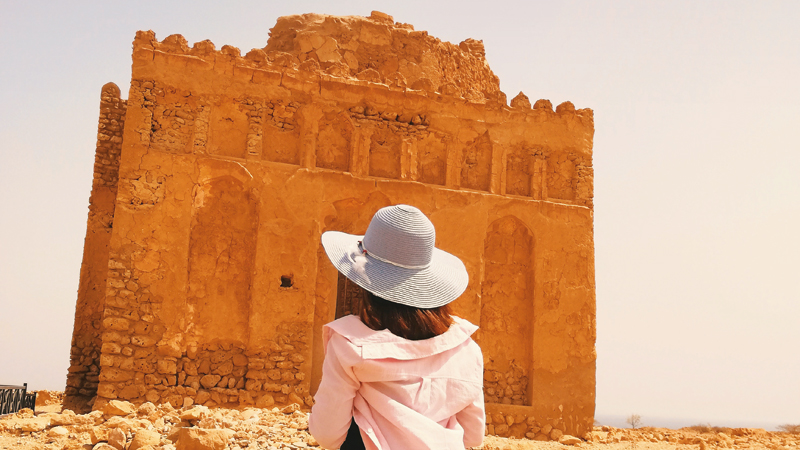

Long time ago, Qalhat would have been buzzing with different activities. One of history’s successful harbour cities, it once welcomed ships from India, Yemen and Dhofar and it hosted thousands of men trading different commodities.
But even the most vibrant and successful of ancient cities fall. And Qalhat was no different.
Today, it is hard to imagine the ancient beauty of this coastal plateau. Covering a total area of 35 hectares, the fortification walls and defense towers have all crumbled. Any semblance of a well-built city is gone and the only reminder of its glorious past is a golden, rock-made ruin which everyone calls Bibi Maryam.

It’s easy to miss Bibi Maryam Mausoleum as one passes through the road that connects Shab and the main area of Sur. The concrete barricades on the main highway hide the area where the mausoleum is built.
It has to take a conscious effort to pinpoint its location and due to renovations and enhancements, it will be awhile before the authorities open it again for public viewing.
Sitting on the opposite side of a dried up wadi, one has to hike for about 20 minutes to see this historical structure. Experts claimed that the city of Qalhat is very similar in its architectural aspects to the Kingdom of Hormuz in Iran. It makes a lot of sense if it was built under the control of the King of Hormuz.
Today, the site itself is in a disarray. A small temporary shelter sits at the left side of the mausoleum. It serves as the living quarters for the security and staff who manage the area.
The shrine itself is very impressive for lasting to this day. Measuring around 30m long and about 25m deep, it has a basement and an underground corridor that is still accessible to this day. The windows and doors are barricaded by metal bars that keep the public away.
Overlooking the sea, there are different versions of what the structure really is. While the popular opinion is that it is a mausoleum that was built by Bibi Maryam for herself and her husband, there are some who claimed that it also once served as a mosque.
One thing everyone seemed to agree on is the fact that the harbour city met its end in 1508.
Brief history
An untrained eye won’t be able to tell how the harbour city of Qalhat tragically met its end. You can’t tell it from the thousands of small stones that litter the whole space.
Historical records showed how Ayaz, a Mamluk slave of the King of Hormuz was entrusted to be the governor of Qalhat. Upon his return to Persia, he installed his wife, Bibi Maryam, as the governor of the city. He eventually retired in Qalhat in 1312 CE and died three years later.
The widow Bibi Maryam played an influential role in the affairs of the city until her own death (date unknown.)
While some stories said that the city was ravaged by an earthquake, it would eventually fold due to the attack led by Portuguese conquistador Afonso de Albuquerque in 1508.
The ancient city of Qalhat including the mausoleum of Bibi Maryam is currently on the tentative list of Unesco. A tentative list according to the organisation, “is an inventory of those properties which each State Party intends to consider for nomination. Nominations to the World Heritage List will not be considered unless the nominated property has already been included on the State Party’s Tentative List.”
The Permanent Delegation of the Sultanate of Oman to UNESCO, in its petition, has said that “the ancient city of Qalhat stands as a unique testimony on cultural traditions and an ancient civilization” and that it “is an outstanding example for an early typical city port representing important stages in the history of mankind.”
“There is no other harbour site on the Arabian Peninsula where remains of the 13 -15 century can be comparably comprehensively studied, neither at Al Balid, Muscat, Sur or Sohar,” it claimed.
Note from the writer:
When we visited the mausoleum, we were told that it is still not open to the public. Even from a distance, just parked at the side of the road, the mausoleum stands proudly in all of its ancient glory. It’s definitely worthy of a visit for its historical significance.
Oman Observer is now on the WhatsApp channel. Click here



